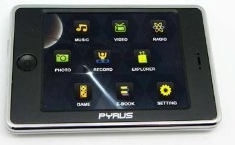Zeke brought this for show and tell today. It looks like a great deal at $49.99 & free shipping.
Thanks for your post Grant; it is an excellent deal for a budget handheld multimedia player, IMO. The shipping is free, only if you meet certain conditions, which I don’t. However, shipping fee for ground delivery is trivial, and the item was delivered just two days after my order!
He said for twice the price he couldn’t find anything with this screen size and features.
The brand name is Pyrus, and they do have various versions, but with a smaller screen. For example, if you also want the camera feature (or more storage space), the screen is only 2.8″. I looked at other brands in the below-$70 range, and did not find any screens larger than 3″ with such an excellent customer rating as this one (4.5 out of 5 stars average from 12 reviews).
If you find the files aren’t being recognized, he reformatted his SD card as fat32
One of the nice features with this player, is you can view the files w/o any proprietary application…any old file manager will suffice. That, plus the FAT32 format, makes it 100% Linux compatible. So you can simply click and drag your files over to the Pyrus player. Just remember to clear the trash folder promptly after removing older files, or your 4G drive will quickly fill up!
I think my Pyrus files got screwed up, due to Windoze Vista’s notorious mishandling of SDHC cards. (I was checking out this device in both Ubuntu and Vista.)
Suddenly on day 2, I couldn’t delete the files in trash, in fact I couldn’t even see the trash folder, though I had Nautilus (and Explorer) set to view hidden files. This corruption is common in flash chips, and the solution is almost always, to simply reformat the drive in question. However, I was hesitant, not knowing if Pyrus used any part of this partition for the OS.
(Let me take a moment now, to thank Charles and Michael at our last BUUG meeting, for their guidance in solving this problem…without their aid, it would’ve taken me much longer to discover the solution.)
After hemming and hawing, I concluded the logical likelihood that Pyrus’ OS was on a separate chip altogether…otherwise, there would be too many complaints and returned devices for the company’s own good. So I took the plunge and boldly reformatted the storage chip. To my happiness, all was copasetic, and I could transfer whatever files I wanted, once more.
For the technically curious: I did view the SD chip with gparted, and found no additional partitioning of that drive. But I did wonder if perhaps there was some proprietary setting that hid any possible extra partition, on which resided the OS, or part thereof.
Also, when I view device information (via gparted), model type is “emerson mp3”. This may prove useful for any hacking ventures.
with gparted but it worked great after that. It charges with the USB port but one minor limitation is you can’t use it while it’s charging.
The device does come with a USB cord, identical to the kind that come with most digital cameras. Rather than leave a computer turned on, in order to recharge my Pyrus overnight, I use a USB hub that comes with its own AC power supply…very convenient for all USB-rechargeable devices.
This player’s rechargeable battery provides approximately 3.5 hours of use before it poops out. A full recharge seems to take an hour or so…though I haven’t really paid close attention in this particular matter, yet. Seeing as I’m in the habit of just plugging it in to my netbook when I’m online at a coffeehouse…or just plug it in at night while I’m playing with my (desktop-replacement) laptop, or sleeping.
It seems to recognize more video formats than many of it’s competitors.
Pyrus boasts that it handles .mp4 and .wmv, along with all the other usual formats. For audio, it does run .ogg right along with .mp3…a plus in any Linux user’s book! Another plus, is that Pyrus automatically sorts all .mp3 files by category…based on any info embedded within these files. So you can view your audios by artist, album, genre, and so on.
All files are dumped in the root folder…except for any recordings you make, which are placed in a folder called “record”. Apparantly, Pyrus identifies format types by extensions, such as .txt, .avi and .mp3. The touch screen’s home menu is very attractive and uncluttered. Click on an icon such as “video” or “music” or “ebooks”, and only the files w/the appropriate extension will show up. There is also a file manager (“explorer”) that allows you to scroll through your entire list of files.
The videos display in excellent clarity, crisp and colorful…though you can’t view them at all in direct sunlight. The ebook feature is really text only…but that’s fine by me, as you can easily convert any ebook format into text with “calibre“, a Linux application available via the package manager. Recordings are somewhat low quality and only saved in .wav format, which is a real space hog. But it’s handy for recording quick reminders and shopping lists. The Pyrus also provides FM radio, also recordable (though not practical, due to the hoggy .wav format).
It also handles images: .jpg, .bmp and .gif only. This includes animated .gif’s, if that’s your cup of tea. You can rotate pictures, and zoom in or out…though this only works for .jpg’s and .bmp’s. (Pyrus claims only to support those two image formats, BTW. Also, for whatever reason it can’t handle “.jpeg” even though it’s identical in format to “.jpg”. You can just rename the extension before copying to the player.)
There is also a “game” section, where you can play either “snake” or “slide”…neither of which is worth your time: they’re poorly presented, at best. No way to add any additional games. But I didn’t choose a handheld player for games…or for any other features except video and audio, both of which are superb. The attractive bonus for me, is the “ebook” option.
You can bookmark your text files, and resize the font in three modes (small, medium, large). Also, you can play an mp3 music file in the background, while reading an ebook. But you can’t do same w/the radio.
Pyrus also has a simple “settings” section, where you can control the lighting, shutdown time, and even language (English, German, and the four major Romance languages). The player comes with a stylus, though no way to latch it onto the device. But I prefer to use my index finger, which works just fine. Also comes with a drawstring pouch, a useless manual, and equally useless mini-CD.
I originally sought an mp3 player, in order to listen to original progressive talk shows from around the country (in podcast form), and audio books. But when I began looking around for a good device at a bargain, I was impressed with some of the video options now so popular. Much more convenient to play a video from my handheld, than from a laptop, even my netbook, when riding public transit. The crisp 3.5″ screen is easy on the eyes.
I do not pay for any podcast subscription, as there are many free podcasts out there, both for music and for talk. If you really want bleeding edge songs and compositions, this is the way to go…as even the fee-based subscriptions are mostly mainstream these days. I use two different podcast aggregators, which provide a wide variety of subject matter from which to choose. They are “Miro” and “Gpodder“…both applications download your subscribed channels, that you may listen (or view) directly from your drive w/o the Internet.
Both applications can be installed via Ubuntu’s package manager, BTW. Miro specializes in video podcasts, but now includes an ever-growing list of audio channels. Gpodder has mostly audio, but is now adding video podcasts to its service. All podcasts provided are 100% free and legal…so no worries.
I’m also subscribed to a podcast web site, “Podcast Alley,” for additional shows that may not be listed in those two applications:
You can add any podcast channel from Podcast Alley, to your podcast aggregator of choice, via the channel’s RSS feed. Or, you can simply download their shows directly to disk. Whatever podcasts I want to listen to (or watch) via my Pyrus handheld, I simply copy to its 4G flash drive…or in the case of Gpodder, “export” them over.
Four gigabytes is more than enough to include a few full-length movies and/or TV shows…in addition to short videos, mp3 sound tracks, and ebooks. Anything I want to save in a permanent collection, is stored on my home computer. That way, I can freely delete shows/files I’ve already played from my Pyrus, and add new ones. For someone who doesn’t want a fee-based mini-media player, or a pricey phone service to go with it…yet would enjoy watching videos and listening to audio podcasts for a really great price, you can’t beat the Pyrus multimedia player. It’s all touch-screen based (except for a little button for image rotating/resizing), and solidly built with brushed-steel frame and back. A real delight for its purpose!
http://www.amazon.com/3-5-Large-Screen-Electronics-Multimedia/dp/B001HC6XMO
If anyone has hacked one, let us know.
I’m sure it would be a fun jailbreak, thanks to its basic design and low price. The 4G storage chip is sealed inside (not removable by normal means). The Amazon.com page for the Pyrus does show a flash card as something that is “Frequently Bought Together”…which is needlessly deceptive. Gives the impression that the Pyrus has an SD card slot, when in fact, it certainly does not. Almost definitely, this device runs on some variation of Linux. I mean, what else could the OS be…Windoze 7? NOT! 😀
—
Zeke Krahlin
http://zekeblog.wordpress.com

